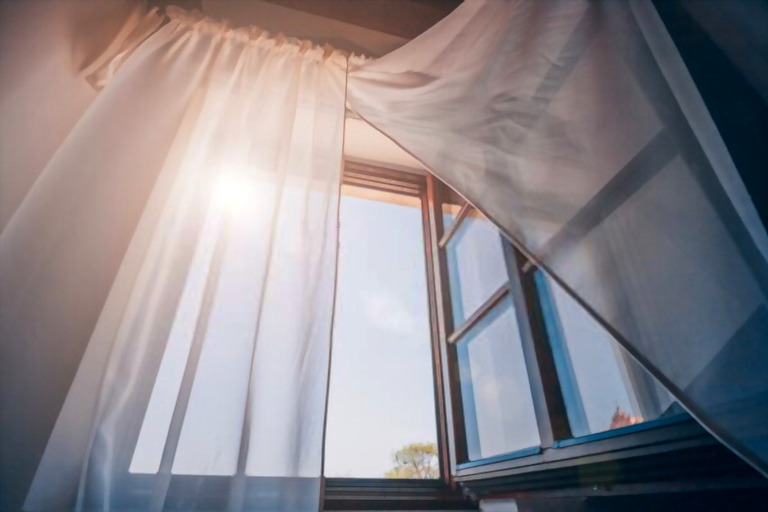
It’s really uncomfortable and frustrating to stay in a high humidity space.
As the air is saturated with water, it is difficult for the sweat on your skin to evaporate, leaving a warm and sticky feeling on your skin. Urg!!!
If that is also your current problem, keep reading, here are the eight ways on how to lower humidity in the house.
Open Windows Or Doors

To lower humidity in a room, it’s important to make it well-ventilated. While there are many ways to ventilate a specific space, the fastest and easiest way is opening all windows and doors.
Once the air movement is back and forth your house, the humidity level is neutralized.
You don’t have to open windows and doors all day, just about 15-30 minutes every morning and night. Pay extra attention to those areas that usually have high humidity like the kitchen and bathroom.
Fans
For souped-up ventilation, keep fans or vents on.

While floor fans are optimal and affordable to ventilate small spaces, I suggest equipping an appropriate ceiling fan if your house is spacious. There are a wide range of sizes and shapes of ceiling fans that deliver various amount of airflow to surely suit your need.
Check Your Walls

Frequently, check the external walls of your house to make sure there’re no holes or cracks. In case that you find some, instantly fix them.
The reason is through these cracks and holes, the warm, humid outdoor air – especially during those summer or rainy days – will travel indoors. And, when the indoor temperature gets cooler than the outside, like when you use air conditioners, such moist air will condense.
During a long time, if that condensation isn’t wiped off completely, it will introduce mold and mildew, and even more to your house. The result is not just your indoor air but also the furniture and wood stuff or wood flooring will be seriously damaged.
Replace Rugs
Especially kitchen rugs and bathroom rugs because these two areas are arguably the most humid spots in the house.
Rugs are utilized to capture moisture and excess water from your feet to keep them dry before you walk to other zones in the house. But the evaporation ability of these rugs themselves aren’t that efficient.
Day after day, they get moist and then dry continuously, which will be a relatively ideal environment for mold and mildew to grow.

So, after 2-3 months of use, remember to wash them thoroughly and replace them annually.
Dry Your Clothes Outdoor
Hanging wet or moist clothes indoor will increase the humidity level, especially if that living space is poor-ventilated.

Change your habit! Dry your clothes outdoor. It’d best if you have a sunny backyard because you can take advantage of this area to hang your clothes up and naturally dry them.
But I also understand that some people who live in an apartment with no balconies, an alternative solution for you is using a clothes dryer.
Take Shorter And Colder Showers

You’ll easily find your bathroom mirror blurred after a hot shower, which is moisture.
And the amount of moisture produced during hot showers is many times higher than that with cold water. It’s because hot showers require steaming the water.
Meanwhile, the longer the showering time, the more moisture made. That’s the reason why I suggest you take shorter and colder showers whenever it’s possible, like in the late spring and summer.
Besides, after taking a shower, don’t forget to open the window for better air ventilation. If this is inconvenient for you, just leave the exhaust fan on a little longer.
Okay, the six options above are the simplest and cheapest solutions that I guess anyone can do to lower their house’s humidity levels. But if you want to optimize the effects and your budget is on the table, try these advanced solutions:
Get A Dehumidifier
This is considered the most surefire way to cut off the excess humidity in one’s house. Contrasting to the humidifier, a dehumidifier withdraws warm, moist air through a fan then move it to the machine’s refrigerant cooled coils to condense.

There are plenty of dehumidifiers in different sizes, shapes, and a number of functionalities for you to choose from.
Some models are small enough to fit under a furnace air handler or big enough to dehumidify a large space. You should consider what is exactly your needs as well as do you want any additional function in this machine.
Don’t worry about the price ranges, it is very various.
Use Charcoal Briquettes
Charcoal briquettes are known for their superb absorption of moisture and odors so, taking advantage of this property to remove your indoor humidity is not a bad idea.

Moreover, a bag of charcoal briquettes is very cheap while the amount you need to dehumidify a room is not huge. Just a basket is enough. If possible, find coconut shell charcoal for the highest moisture absorption properties and avoid powdering issues in absorption.
Each bag of charcoal briquettes can last up to 3 months.
Conclusion
I’ve listed out the nine optimal ways, ranging from simple and cheap to a bit costlier yet more effective, to lower humidity in the house. If your house is currently high in humidity, find a solution as soon as possible to avoid any worse consequences that happened to your space and furniture.
That’s all for this article. Thanks for reading!













